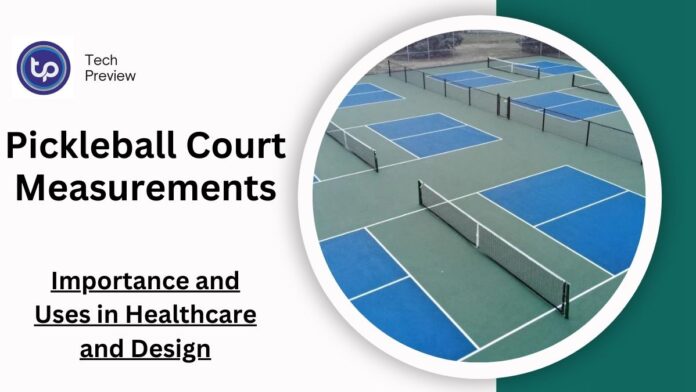Pickleball, a sport that combines elements of tennis, badminton, and ping-pong, has gained massive popularity in recent years. One of the reasons behind its rapid growth is its simplicity, which is reflected in the court design.
Whether you’re setting up a casual backyard game or preparing for a professional tournament, understanding the precise dimensions and layout of a pickleball court is crucial for ensuring fair play and enjoyment.
In this article, we’ll explore everything you need to know about pickleball court measurements, including dimensions, key areas of the court, surface materials, and tips for setting up your own court.
Standard Pickleball Court Dimensions
A pickleball court is relatively small compared to a tennis court, making it more accessible for players of all ages and abilities. The dimensions for a standard pickleball court are the same for both singles and doubles play, which adds to the sport’s simplicity.
- Length: 44 feet (13.41 meters)
- Width: 20 feet (6.1 meters)
These dimensions mirror those of a doubles badminton court, meaning that some existing badminton courts can be repurposed for pickleball. However, it’s important to note that the recommended playing area, including space around the court, should be larger to give players room to move comfortably.
The total playing area is ideally 34 feet by 64 feet (10.36 meters by 19.51 meters) to accommodate additional space outside the court boundaries for running and lunging.
Key Sections of the Pickleball Court
The layout of a pickleball court is divided into several distinct sections, each with specific rules for gameplay:
- Non-Volley Zone (NVZ) or Kitchen:
- The non-volley zone, commonly referred to as the kitchen, is a 7-foot (2.13 meters) area on both sides of the net. Players are not allowed to volley the ball (hit it in the air without bouncing) while standing in this zone. This unique rule is designed to prevent overly aggressive play near the net.
- Service Areas:
- Each side of the court is divided into two service areas, separated by a centerline. These are the left and right service areas, measuring 10 feet by 15 feet (3.05 meters by 4.57 meters) each. The server must aim to land the ball within these designated areas, depending on where they are serving from.
- Sidelines and Baselines:
- The sidelines are the boundaries that run the length of the court, while the baselines mark the ends of the court. These lines are critical in determining whether a ball is in or out of play. The lines themselves are typically 2 inches (5.08 cm) wide and included in the overall court dimensions.
- Net:
- The net divides the court into two halves. It is positioned at the height of 36 inches (91.4 cm) at the sidelines and dips slightly to 34 inches (86.4 cm) at the centre. The net width is typically 20 feet (6.1 meters), matching the court width, ensuring that all shots over the net are well within the playing area.
Surface Materials and Court Setup
Pickleball can be played on a variety of surfaces, including concrete, asphalt, or indoor gym floors. The surface should be flat and smooth to allow the ball to bounce correctly, with textured acrylic coatings often used to provide grip and prevent slipping.
For outdoor courts, additional considerations include setting up windbreaks and fencing to contain the ball. Courts are typically oriented north-south to avoid players facing the sun during play. The court lines should be painted with acrylic paint for permanent setups, or tape can be used for temporary courts.
Differences Between Indoor and Outdoor Courts
Although the dimensions of indoor and outdoor pickleball courts are identical, there are some key differences in how the game is played based on the environment:
- Indoor Courts: Typically use gym floors, which provide less bounce and may require adjustments in play style. Indoor settings eliminate weather factors like wind and sun but can be noisier when multiple games are happening at the same time.
- Outdoor Courts: Outdoor pickleball is commonly played on tennis or basketball courts with added pickleball markings. Players must account for wind, sun, and other environmental conditions, which add an extra layer of challenge to the game.
Why Pickleball Court Dimensions Matter
Ensuring that a pickleball court is set up with accurate measurements is crucial for fair play, safety, and enjoyment. Incorrect dimensions can lead to:
- Unfair Gameplay: Courts that are too small or too large can create imbalances, making it difficult for players to properly position themselves and hit shots accurately.
- Safety Hazards: If there isn’t enough space around the court, players may run into obstacles or collide with each other, increasing the risk of injury.
- Inconsistent Bounces: A poorly constructed court with uneven lines or surfaces can cause the ball to bounce unpredictably, negatively affecting the quality of play.
Conclusion
Pickleball’s popularity has skyrocketed due to its accessibility, fun gameplay, and relatively simple court setup. Understanding the correct court dimensions and layout is essential to playing the game correctly and safely.
Whether you’re building a court in your backyard or setting up a local community space, adhering to the official dimensions will ensure that every match is fair, competitive, and enjoyable for all participants.
Sports like pickleball rely on precise measurements, just like how body measurements can impact success in fitness and modeling. If you’re fascinated by the role physical characteristics play in sports, check out Anthropometric Measurements to explore the science behind it. Looking for fitness inspiration? See how influencers like Faiiryquadmother motivate their followers with workout tips, or read about how Kaitlyn Krems combines fun and fitness on social media.









